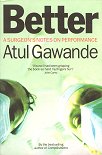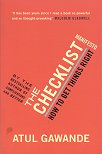For most of human history, death was a common, ever-present possibility.
But now, as medical advances push the boundaries of survival further each year,
we have become increasingly detached from the reality of being mortal.
So here is a book about the modern experience of mortality –
about what it’s like to get old and die,
how medicine has changed this and how it hasn’t,
where our ideas about death have gone wrong.
In a story that crosses the globe, Atut Gawande examines his experiences
as a surgeon and those of his patients and family,
and learns to accept the limits of what he can do.
Never before has ageing been such an important topic.
The systems that we have put in place to manage our mortality are manifestly failing;
but, as Gawande reveals, it doesn’t have to be this way.
The ultimate goal, after all, is not a good death,
but a good life – all the way to the very end.
We are all going to die. Hopefully, we will live a long and healthy life first.
But the fear is always of a slow, lingering, undignified death.
In this deeply moving and thought-provoking book,
physician Gawande demonstrates why modern medicine is not set up to cope with the inevitability of death.
Much medicine is about heroic acts that, through strict treatment regimes, violent surgery and toxic drugs,
make us better, after we have suffered through the warfare between illness and cure.
Death is failure.
But people who are nevertheless dying will not get better:
medicine offers only the debilitating warfare, with no peaceful recovery after.
All pain, no gain. Only failure.
Is there an alternative to the standard end-of-life route of incarceration in a nursing home,
made subject to loss of independence and an infantalising regime of “doctor knows best”,
accompanied by ever more violent interventions,
culminating in dying in a sterile hospital bed while attached to tubes and beeping machines?
Gawande describes his discovery of this alternative:
patient-centric palliative care,
carefully discovering what the patient wants from their remaining time,
and ensuring they get that:
time at home, time with family, time to enjoy what time is left,
medical care appropriate to that,
and, if it is what is wanted, further interventions.
And the consequences of this approach,
of providing the patients what they want,
of not insisting on providing the fullest medical interventions possible,
are possibly counter-intuitive:
[pp177-8]
A landmark 2010 study from the Massachusetts General Hospital had even more startling findings.
The researchers randomly assigned 151 patients with stage IV lung cancer
... to one of two possible approaches to treatment. Half received usual oncology care.
The other half received usual oncology care plus parallel visits with a palliative care specialist.
....
The ones in the study discussed with the patients their goals and priorities
for if and when their condition worsened.
The result: those who saw a palliative care specialist stopped chemotherapy sooner,
entered hospice far earlier,
experienced less suffering at the end of their lives—and they lived 25 percent longer.
In other words, our decision making in medicine has failed so spectacularly
that we have reached the point of actively inflicting harm on patients
rather than confronting the subject of mortality.
So end-of-life medicine needs to change to incorporate quality of current life,
not just quality of later (here, non-existent) life.
And quality of life nearly always means independent living, and dying, at home.
We need to move from second stage medicine to third stage:
[p192]
Scholars have posited three stages of medical development that countries go through, paralleling their economic development.
In the first stage, when a country is in extreme poverty,
most deaths occur in the home because people don’t have access to professional diagnosis and treatment.
In the second stage, when a country’s economy develops and its people transition to higher income levels,
the greater resources make medical capabilities more widely available.
People turn to health care systems when they are ill.
At the end of life, they often die in the hospital instead of the home.
In the third stage, as a country’s income climbs to the highest levels,
people have the means to become concerned about the quality of their lives,
even in sickness, and deaths at home actually rise again.
Gawande, with a combination of heart-rending, and heart-warming, case studies,
and hard medical data, argues convincingly for this change,
and for an extension of the palliative care approach.
It is more humane, it improves quality of life and lifespan,
and, if more argument is needed, it is cheaper.
Some may be concerned that allowing people to choose not to undergo medical procedures
might lead to people feeling they have to choose this route so as “not to be a burden”.
But many of the people Gawande spoke to who had chosen to go the route of more interventions,
had done so not because they wanted to,
but because of pressure from their families who, understandably, didn’t want them to die.
This is an important book that should be read by all people involved in
delivering medical care, all involved in medical policy,
and all who will one day be at the end of their own lives.



